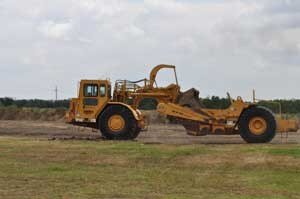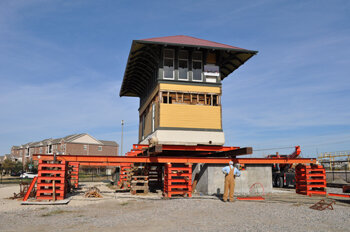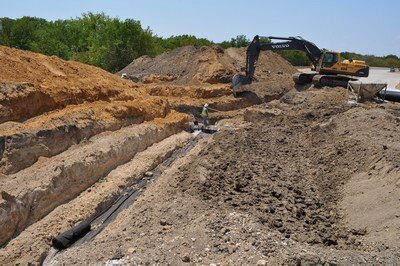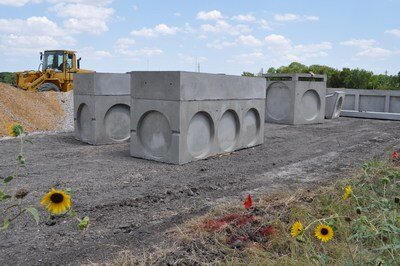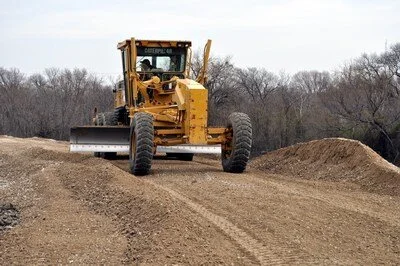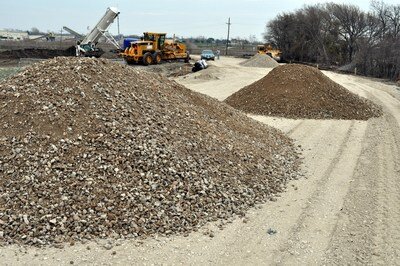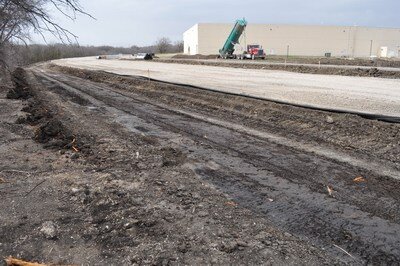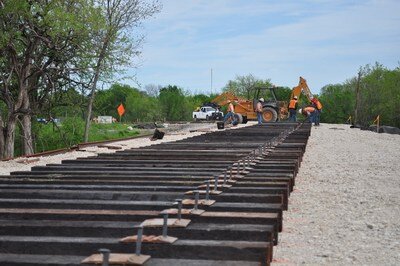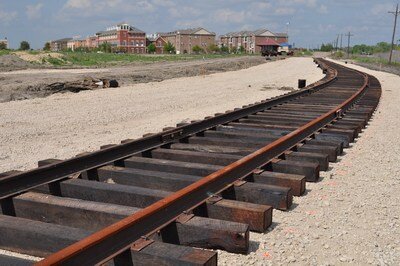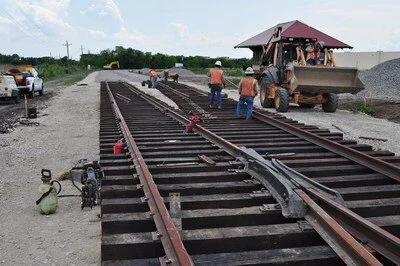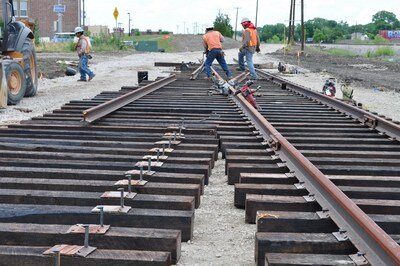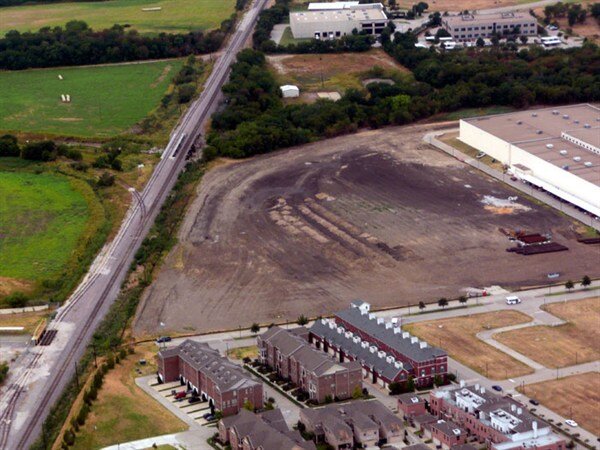Construction
Frisco Groundbreaking, May 31, 2011
Nearly 200 supporters including Frisco City Officials, representatives from the Railroad Industry, and members of the press gathered to celebrate the Museum’s groundbreaking in Frisco. The event marked the first day of Phase 1A construction of facilities, which upon completion will accommodate the Museum’s collection of historic trains. Museum CEO Bob LaPrelle, Frisco Mayor Maher Maso, and Museum Board Chair Thomas Smith addressed the crowd at the 11:00am groundbreaking. At exactly 11:15am, a northbound BNSF freight train arrived on cue to create a dramatic and festive backdrop to the ceremony.
The actual groundbreaking with ceremonial spades took place at approximately 11:45am.
Group 1:
John DeGolyer Maxson, Vice Chair, Museum Board of Trustees
Thomas Smith, Ph.D., Chair, Museum Board of Trustees
Hon. Maher Maso, Mayor of Frisco
David Porter, Board Chair, Frisco Economic Development Corporation
Allen Biehl, President, Frisco Community Development Corporation
Bob LaPrelle, President & CEO, Museum of the American Railroad
Ronald Jackson, General Manager, Texas Division, BNSF Railway
Group 2:
Hon. Maher Maso, Mayor of Frisco
Pete Hosp, Frisco Heritage Center Coordinator
Bob Allen, Councilmember, City of Frisco
Peter Streit, Chair, Frisco Convention & Visitors Bureau
Heather Bowers, Director, Frisco Community Development Corporation
Cynthia Hurley, Vice President, Frisco Community Development Corporation
Allen Biehl, President , Frisco Community Development Corporation
Gary Carley, Secretary, Frisco Community Development Corporation
Jeff Cheney, Councilmember, City of Frisco
Our sincere thanks to the many contributors and supporters of Phase 1A Construction.
Special thanks to Dana Baird-Hanks, Pete Hosp, and others with the City of Frisco, Sharon Roland and Frisco Arts, Erica Yaeger and Sci-Tech Discovery Center, Ron Jackson, Joe Faust and BNSF Railway, Ken Creager, Bob King, and the Heritage Association of Frisco, along with our many valued Museum Members and Volunteers for making the groundbreaking and reception a very successful and memorable event. Thanks also to Ellen H. Rogers of Dallas for sponsoring catering of the reception by Margaux’s Restaurant, and Irwin Arnstein for providing photographs and video services for the event.
Groundbreaking Image Gallery
1953 Track Speeder Courtesy of the Heritage Association of Frisco
2011 Museum Board of Trustees
A crowd gathers to celebrate the Museum's groundbreaking
Actual Grading of the site takes place following the ceremony
Attendees enjoy a reception inside the Frisco Discovery Center
CEO Bob LaPrelle addresses attendees
Frisco Mayor Maso addresses attendees
Members of the Museum Board of Trustees
Museum Board Chair Thomas Smith addresses attendees
Museum Groundbreaking, Group 1
Museum Groundbreaking, Group 2
Special thanks to Museum Volunteers who greeted guests at the reception
August 1, 2013 - Museum Old Fair Park Site is Dismantled
H&TC depot following its move to Fair Park in August, 1963
It was 50 years ago this month that the original "Age of Steam" exhibit was being created at Fair Park. In preparation for the 1963 State Fair of Texas, the small attraction received two additional items during the month of August: recently retired Dallas Union Terminal steam locomotive #7 and Southern Pacific's Eakin Street Yard Office (H&TC Depot).
Now 50 years later, an era is drawing to a close as trackage is being dismantled at the Fair Park site. Nearly 2,000 feet of track that displayed some 28 pieces of vintage rolling stock is being pulled up this week.
The original Texas & Pacific spur dating back to a period prior to the 1936 Texas Centennial Exposition was used to exhibit the first two locomotives which included T&P's "Texas" type steam locomotive #638, and later the ex-New York Central "Mohawk" steam locomotive #3001 masked as T&P #909.
Ttrackage being dismantled August 1, 2013
Additional trackage was constructed as pieces were added to the Museum. Major expansions took place in 1965 with the arrival of three additional steam locomotives: Big Boy #4018, Frisco #4501, and Eagle Picher Mining Co. (ex-Frisco) #1625, and again in 1969 with the arrival of Santa Fe Motorcar M-160 and Coach Observation #3197. A couple of modest track expansions took place in the 1990s to make more efficient use of the 1.5 acre site.
The Museum's rolling stock collection continued to grow in subsequent years despite a lack of additional trackage, necessitating storage of approximately 1/4 of the pieces offsite. With nearly 3,000 feet of rolling stock, the Fair Park site had become obsolete, which contributed greatly to the Museum's decision to relocate to the new 12.34 acre Frisco location. Some 3,200 feet of track has already been constructed at the new facility. An additional 3,000 feet of exhibit track will be laid as part of the second phase of construction, once funds are in place.
March 8, 2013 - Track Extensions Complete
After weeks of weather delays, construction of additional trackage was completed this week. The work will enable the Museum to unload the two steam locomotives and tenders currently on flat cars at the site.
In order to unload the flat cars on the Museum's new shop lead track, "pocket" tracks are necessary to accommodate each car when empty. These are 100-foot extensions to existing turnouts that will ultimately become leads to exhibit tracks.
When the steam locomotives are lifted off the flat cars, each car will be pulled from beneath the cranes and then shoved in the clear on the pocket tracks. This is necessary due to the limited amount of tail track which necessitates handling each flat car individually. With 2/3 of the Museum's rolling stock now in Frisco, great care must be given to the logistics of unloading and positioning the flat cars and new arrivals.
Crocker Crane is scheduled to unload the steam locomotives on March 20th. This, of course, is dependent upon the weather. The site must be dry in order for the cranes to have a good footing for lifting - the Frisco #1625 Decapod weighs 200,000 lbs. For each inch of rain, 1 1/2 weeks of dry weather is required for the site to accommodate heavy equipment.
March 6, 2013 - Additional Rail Arrives in Frisco
Additional rail for future track construction arrived at the site today. Transported on three semi-trucks, the 90 lb. rail will be used for construction of the eight tangent exhibit tracks as part of the next phase of track work. The rail, some 4,000 feet, was a gift of the Santa Fe Railway nearly 20 years ago. It became surplus following closure of the East Dallas classification yard to make way for DART's light rail Service and Inspection facility just west of Fair Park.
The rail has been in storage at Kirk Service Company's lot on Hickory Street. Kirk has been a long-time supporter of the Museum, having provided several Carrier air conditioning units for structures and rail cars over the years. Four signal bridges which were dismantled and moved to the Kirk site from the Tower 19 Interlocking will also be moved to Frisco for eventual reassembly and erecting.
The East Dallas rail joins some 3,200 feet of rail already on the site. Also slated for use on future exhibit tracks, this rail was purchased from the Museum's contractor, Trac-Work Incorporated at the onset of construction. It was salvaged from Santa Fe's Kansas City Mexico & Orient (KCM&O) line near San Angelo.
December 31, 2012 - Aerial View of Museum Site
As 2012 draws to a close, the image at left shows considerable construction progress at the Museum's new Frisco location. The entire site has been graded and is now at as-built elevations in most areas, including lead and tail tracks. An extensive system of underground storm drains has been installed, including a major drainage culvert and headwall that carries water from over 20 acres to nearby Stewart Creek. Nearly 3,000 feet of trackage has been installed, including 5 switches, along with BNSF's main line switch.
Half of the Museum's rolling stock collection (20 pieces) can be seen on the main and runaround tracks. The circa 1900 Houston & Texas Central Depot has been placed on its permanent foundation piers, and new roof decking has been applied. The 1903 Santa Fe Interlocking Tower 19 has been reassembled and now rests on its new concrete base. The Museum site is now fully secure with ornamental iron fencing along its perimeter. Work is nearly complete on Phase IA construction, which enables the Museum to vacate its Fair Park location of nearly 50 years. Our thanks to Museum member Steve Blackman for providing periodic aerial photographs during flyovers of the site.
December 6, 2012 - Tower 19 Reassembled
Crews with H. D. Snow & Son placed Tower 19 on its permanent foundation today. The three-day process involved placing beams at each end of the Tower that extended eastward to the adjacent foundation. The Tower was then rolled along the beams some 25 feet to a point just above the new foundation. Using hydraulic jacks, the beams were carefully lowered, allowing the Tower to gently settle on its base. Some adjustment was necessary in order to achieve proper alignment. The Tower, weighing in at 100,000 lbs., was moved three additional inches to the east using a system of jacks, sliding plates, and soap. The Tower was then lowered again, this time onto a thin bed of mortar which filled any imperfections and created a bond.
With Tower 19 now permanently placed on its base, reconstruction can begin on the structure itself. A system of splints has been used to attach and reinforce the two sections of the Tower that were separated for movement to Frisco. Additional reinforcement will be added, followed by the application of as much of the Tower's original siding as possible. Some additional siding may be milled as necessary to complete repairs to the exterior.
Our thanks to Brian Lingle at Lingle Engineers of McKinney for assisting in the placement of the Tower this week. The placement concludes the services of H. D. Snow & Son House Movers. Our sincere thanks to H. D. Snow, his son Gary, and the rest of the crew for an outstanding job moving the Depot and Tower 19 to Frisco. They used great skill and diligence in moving these two historic structures to their new home.
October 4, 2012 - Reconstruction Begins on Depot Roof
Reconstruction of the Houston & Texas Central depot's roof is underway. Using the original materials removed several months ago, the roof is beginning to take shape again. Once the rafters are in place, the original lath work will be applied along with the tongue-in-groove pieces on the eaves. Great care is being given to maintaining the historical integrity of the roof, with the substitution of new materials only where absolutely necessary.
September 28, 2012 - Tower 19 Foundation/Base Completed
The third and final pour for Tower 19's base is now complete. The base which also makes up the first floor has been carefully replicated, including original window and door openings. The forms have been removed and the concrete is now curing in preparation for the placement of the second and third floors of the Tower. New wood doors and sashes will be made for the first floor based on historic photographs and drawings. The first floor originally housed the battery room and cable termination room.
September 16, 2012 - Additional Track Work Underway
Work is progressing on additional track work. As part of a change order to the original Phase IA trackage, the Museum's shop lead is currently under construction. It includes an additional switch and 450 feet of track which curves around the east side of the H&TC depot. This track will eventually continue north to the Museum's restoration shops which will be built at a later date as funds allow.
The location of the depot was changed from the original Site Plan to a point along the shop lead in order to add context and authenticity as an exhibit. The shop lead will allow for the display of rolling stock adjacent to the depot and enhance the visitor experience. It is likely that the Museum's Frisco steam locomotive #1625 will be placed on this track upon arrival at the site. The #1625 is the wide driver Russian "Decapod" which will not move on its own wheels from Fair Park.
August 14, 2012 - Site Work Continues
Final Phase IA site work is underway in Frisco, including installation of a decorative iron security fence around the perimeter. The 3,400 foot fence will essentially encompass the Museum's footprint including tail track behind the Frisco Discovery Center. The fence is expected to be complete by the arrival of the first pieces of rolling stock in the collection.
Meanwhile, the foundation for Tower 19 is progressing. Piers have been poured and the slab should be completed in a few days. Once the slab has cured, the first floor base will be formed-up and poured. Vertical steel reinforcing rod for the base will be included as part of the slab work. A nice touch will be provisions for original doors and windows in the new base that were not replicated at Fair Park.
Placement of the H&TC depot on its new concrete piers and Tower 19 on its newly-constructed base should take place in a few weeks. Conduit for utilities is being installed as foundation work progresses. We are looking forward to permanently placing both buildings so that reconstruction can begin.
Our sincere thanks to TXI Concrete, Lingle Engineers, Able Concrete Contractors, and N.L. Schutte Foundation Drilling for their generosity and support of the foundation projects.
July 26, 2012 - Track Work Complete!
Frisco City Council Member Jeff Cheney takes a turn at driving one of the final spikes into the last stretch of track.
“Done!” Track work at the Museum’s Frisco site was completed today with a ceremonial driving of the last spikes. Borrowing the word that was telegraphed across the nation in 1869 when the first Transcontinental Railway was finished, we are proud to reach this major benchmark in the construction project.
The brief ceremony was well attended at 1:30 this afternoon by Mayor Maso, Frisco City Council members, representatives of the EDC, CDC, and CVB, along with Museum board, staff, volunteers, and stakeholders. Representatives from BNSF, Lunsford Associates, Venus Construction and Trac-Work, Inc. also participated in the celebration.
Two ceremonial spikes were driven in the final stretch of track that connects the Museum with BNSF and the general system. Mayor Maso and Council Members Jeff Cheney, Bob Allen, and Will Sowell took turns driving the first spike. Honors for the second and final spike were reserved for track workers who have been on the job in the hot Texas sun for several weeks. It is only fitting that their hard work be acknowledged, and a time-honored craft on the railroad be recognized.
With the Museum’s lead track now complete, final preparations are underway for movement of the first train to Frisco. Once approvals are in place, and the railroads’ schedules are adjusted to accommodate moves at reduced speeds, the rolling stock collection will begin its journey northward.
July 14, 2012 - Museum Lead Track Under Construction
Just 400 feet to go! With tamping complete on the southern end of the Museum’s trackage, all that remains is construction of the lead track. Workers with Trac-Work, Inc. began construction on the 400 foot lead that connects the Museum with BNSF’s main line switch on Thursday.
Ties were placed and 50% of the 115 lb. rail was spiked down on the lead by the end of business yesterday. A double switch point derail will be installed as part of the project – a safety appliance required by BNSF. The installation of rail and application of ballast should be complete early next week.
Final tamping of the Museum’s trackage at the north end of the site, along with the lead track, should be complete by week’s end (July 20th). Barring any major weather events, the first pieces of Museum rolling stock should arrive the following week.
June 28, 2012 - BNSF Installs Main Line Switch
The BNSF switch is in! The Museum’s new trackage is significantly closer to being connected to the general system. BNSF track crews installed the main line switch today, a process that took only six hours. The railroad generously donated labor and materials to construct and install the switch that will allow the Museum’s collection of historic rolling stock to move to the new Frisco location. All that remains is 450 feet of lead track to be constructed between the switch and the Museum’s main track just south of Cotton Gin Road. This is scheduled for completion late next week.
BNSF crews endured 101 degrees in the hot summer sun while making short order of the switch installation. BNSF freight traffic was moving again by early evening, when a southbound rock train passed through the switch at 6:20pm. Track workers spent the previous few days reconstructing the switch adjacent to the point of installation. The switch had been used previously on a BNSF line through McGregor.
We are indebted to BNSF for their continued generosity and support of the Museum. The main line switch represents a lead gift to the Frisco Project, and a significant contribution to our expanded programming in North Texas. There was much excitement among onlookers including city officials who observed the switch installation from a safe distance.
We would also like to thank BNSF Track Foreman Ewell Martin, and Road Master William Dombrow, along with each member of today’s crew. Mr. Martin is a veteran at BNSF, having hired out on the Santa Fe 37 years ago. Finally, congratulations to Cody, a member of the crew who officially retired at the end of work today. He concludes 37 years of service since beginning his career on the Fort Worth & Denver Railway in Amarillo.
June 28, 2012 - Frisco Council Member Visits Museum's New Site
Frisco City Council Member Bob Allen visited the Museum’s site this morning and provided an impromptu inspection of recently completed trackage. Mr. Allen brings a unique set of skills and experience to the City’s involvement with the project. He worked in the area of track rehabilitation for the Penn Central Railroad several years ago before moving to Texas.
Allen shared his experiences with Museum CEO Bob LaPrelle as they walked the 2,000 feet of lead and runaround track. He hired out on the Penn Central in 1975 and worked several jobs on the line including Roundhouse Machinist, Hostler, and member of a Section Gang. Section Gangs maintained designated lengths of rail lines, often extending for several miles. Allen worked as a Machine Operator on a track surfacing gang in Hamilton, Ohio. His territory encompassed trackage between Cincinnati and Dayton.
The Penn Central was created out of the merger of the Pennsylvania Railroad and New York Central Lines. The railroad went on to become Conrail in 1976. The Cincinnati Dayton line was later sold to CSX Transportation as part of the government’s divestiture of Conrail. The Museum’s collection features one of the famous GG-1 electric locomotives that operated on Penn Central’s Philadelphia and Harrisburg Divisions. Number 4903 has the distinction of having pulled Robert Kennedy’s funeral train in 1968 while in Penn Central service.
While Allen has moved on to public service here in Frisco, he maintains his seniority on the railroad and speaks proudly of his years with the Penn Central. We were excited to share recent track construction progress with him during his visit. It isn’t every day that a City Council Member drops by a railroad museum to perform a track inspection! The Museum is very grateful to Bob Allen and the Frisco City Council for their continued support of the project.
June 22, 2012
Significant progress was made this week toward completion of track work. The four switches along the transitional trackage south of the Discovery Center are finished and ballast has been spread.
The process of “tamping up” the track began on Tuesday. This is the final stage of construction that brings the track into alignment at the proper design elevation. Tamping is achieved by raising the track up from the roadbed surface and working the ballast (crushed granite) in underneath the ties. A track based machine known as a ballast tamper can achieve the process at any point along the line in just a few minutes. Mechanized ballast tampers make short order of a process that was once slow and arduous, requiring several track workers.
Ballast tamping usually takes two to three passes with the machine in order to achieve final elevation and alignment. The first pass involves raising the track to final elevation at periodic staking points along the line. Each stake is placed according to survey points which indicate location and elevation of the track. Tamping between stakes then takes place to bring each segment up to elevation. Our design specifications call for five to six inches of the granite material to be worked in under the ties. Curved track will have a few degrees of “super elevation” where the outside rail is slightly higher than the inside rail. This “banking” of curves provides for easier movement of rolling stock and effectively lowers their center of gravity. The tamping process should be complete by the end of next week. A final process known as ballast regulation follows tamping. A track based machine removes excess ballast from the upper surfaces of the ties and spreads it to the outside of the track, creating a trim, manicured look to the right of way.
Meanwhile, BNSF track crews have completed construction of their switch which will connect the Museum’s lead track to the BNSF main line. Installation should take place next week, at which time work will begin on the Museum’s lead track. Upon completion of the lead track, the Museum will officially be connected with the general system and movement of the rolling stock collection will begin. This is tentatively scheduled to take place in mid-July.
June 15, 2012
Track construction is 80% complete as of this update. Work has been concentrated on a labyrinth of switches located along the Museum’s transitional trackage south of the Frisco Discovery Center (FDC). Switches for tracks 8, 4, and 3, along with the south runaround switch, are being constructed and will complete the gap in trackage previously installed. Switch construction is considerably more time consuming, as much geometry is involved in the process. Additionally, three of the switches lie within a tangent section of track located between two 15 degree curves making their placement critical.
Each #8 turnout is constructed individually at the site at a cost of nearly $45,000 apiece. An additional switch was added to the scope of track work in Phase IA. The switch will branch off of track 8 and become the shop track lead (RIP track 1 in the Museum’s Site Plan). This change order in track work was done to facilitate the completion of site grading and a retainer wall along the fire lane behind the FDC. The shop lead also provides for maintenance of the Museum’s rolling stock collection prior to the construction of a permanent repair facility. The position of the Museum’s H&TC depot has been relocated on the Site Plan to a point along the shop lead. The new position is just southeast of the original location in the Site Plan. The depot was moved to this point in order to achieve better orientation and context as an exhibit within the Museum. The structure’s historical designation is also assured.
Work has begun on the main line switch to be installed along the BNSF. The switch components have been laid out adjacent to the point of installation. Work on the Museum’s lead track (some 500 feet) is scheduled to begin soon.
Track work at the site and the installation of the main line switch is expected to be complete by the end of June. On the present schedule, and weather permitting, movement of the Museum’s rolling stock collection will commence in mid-July.
May 15, 2012
Track work continues at a brisk pace. Workers measured, cut, and installed rail as part of the construction of the switch that connects the main and runaround tracks just south of Cotton Gin Road. Refer to the photo album below to see the various tasks associated with constructing the switch.
Once the switch is complete, workers will begin construction on the remainder of the turnouts located at the south end of the Museum’s track alignment. Switch ties have already been laid out at this location, and the positioning of “frogs” (the actual point of divergence of the rails) determined.
May 12, 2012
Construction of switches at the Museum’s new Frisco site began this week. A total of six switches in addition to BNSF’s main line switch will be built in this phase of construction. This is a much slower and tedious process than basic track work. There is much planning and geometry involved in building a switch. The placement and degree of turnout is critical to the overall track layout.
The number of switches in Phase IA track construction was dictated by their location in the lead, main, and runaround tracks. Two switches will connect the main and runaround tracks at each end, while other switches will simply be stub-ended until later phases of construction. It was recently decided to add an additional (sixth) switch to this first phase of track work in order to complete grading and application of sub-base material at the south end of the Museum property (behind the Frisco Discovery Center). This additional switch is the turnout for the Museum’s shop track lead that will ultimately connect to a permanent restoration and maintenance facility.
May 8, 2012
Grading and application of sub-base material for the Museum’s lead track to BNSF’s main line is now complete. RPMX Construction, the grading sub-contractor to Venus Construction, completed the alignment on Tuesday. Work included grading, spreading and compaction of crushed concrete for the track bed, as well as extensive drainage correction.
An existing berm just to the west of the Museum’s new lead was narrowed in order to achieve adequate width for the alignment, maintain a 3:1 slope, and provide for drainage. Elevation of the berm was maintained for nearly all of its length. Trees will be planted at the south end of the berm to maintain screening of adjacent areas.
A culvert was installed as part of the lead track project to provide for adequate draining on either side of the alignment. Our thanks to BNSF for coordinating the movement of rail traffic along their line during construction.
Following the installation of BNSF’s main line switch, construction of the Museum’s lead track will begin. This should take place in the next few weeks, at which time the Museum’s trackage will be connected with the general system of rail lines.
May 4, 2012
Track work at many points along the site has progressed to the point of spreading ballast (rock) in preparation for final alignment. The new track sits on a six inch base of crushed concrete. It will ultimately rest on an additional six inches of ballast once work is complete. The ballast is simply dumped on top of the track in quantities sufficient to be eventually worked underneath and fill the spaces between the ties.
Crushed granite was selected as the ballast material for its longevity and appearance. Once all of the track and switches are complete, the granite will be tamped. Tamping is a process by which the track is raised through the ballast by a machine known as a “Tamper”. The ballast is then worked under the ties and compacted, bringing the track to its final elevation and alignment. Following this process, a regulator machine then dresses the surface of the ballast even with the tops of the ties and creates a clean edge on both sides of the track. The result is perfectly tangent or curved track that is resting on a compacted surface to prevent settling from the weight of trains. The ballast also promotes proper draining of rainwater to reduce deterioration of the crossties.
Additional track and switch construction will take place over the next few weeks. Ballast will be applied to these areas as work is completed. The tamper and regulator machines will arrive at the site in a few weeks. These machines will operate on the new track, moving slowly along as they perform their duties. This will be the final process before the track is approved for use and equipment begins to move from Dallas.
Martin Marietta Materials generously provided ballast (over 2,600 tons) at a greatly reduced cost. Trucks from the City of Frisco’s Public Works Department transported the ballast from Martin Marietta’s Frisco facility to the Museum’s site at no cost. We are very grateful to Martin Marietta and the City of Frisco for their generosity and support.
March 30, 2012
Trac-Work, Inc. made significant progress at the Frisco site this week. By this afternoon, over 1,600 feet of track materials had been placed, gauged, and spiked on the Museum’s main line. Ultimately, this track will stretch 2,000 feet from Cotton Gin Road to the westernmost end. Work will begin soon on the runaround track, including five turnouts.
Grading for the final section of track that connects with BNSF’s main line will begin next week. Once the sub-base roadbed material is applied and compacted, Trac-Work will construct the Museum’s lead track, ultimately connecting the site with the general system.
March 27, 2012
Finally, track construction begins in Frisco! Workers with Trac-Work, Inc. began placing new cross ties on the westernmost end of what will become the Museum’s tail track. The first 300 feet of track material was put in place today as part of a 4,000 foot Phase IA track construction project.
Construction will progress in a northeast direction through the Museum site and eventually connect with BNSF’s main line to the north of Cotton Gin Road. Five turnouts (switches) will be constructed in place, along with the Museum’s runaround track. Work is expected to take 30-40 days, weather permitting.
While the ties are new, the rail is being recycled from the Santa Fe (originally Kansas City, Mexico & Orient) Line near San Angelo, Texas. The rail was produced by Colorado Fuel & Iron mills in Pueblo, and the Gary Steel Works near Chicago between 1918 and 1920. Weighing 90 lbs/yard (a unit of measurement for rail), the 39-foot sections will be bolted in place as track work progresses. The Museum’s rolling stock collection currently rests on 65-85 lb rail at Fair Park. Today’s industry standard for mainline railroads is 130-150 lbs/yard.
February 9, 2012
Final preparation of the roadbed for Phase IA trackage is nearing completion. The final layer of the crushed concrete sub-base material is being applied and graded as seen in this view taken today. The sub-base will have a 2% lateral grade for drainage purposes. Once the sub-base passes final tests for density and compaction, track work will begin.
January 24, 2012
Work continues at the Frisco site, however, unforeseen construction issues and several rain events have contributed to delays in the project. Nearly one foot of rain has fallen at the site since our last update of November 1.
Fortunately, Mother Nature has been kind to the project over the last couple of weeks. Crews with Venus Construction and its subcontractor RPM have been working diligently, including weekends, to make up for delays. Final grading has been completed on the site itself, and soil compaction tests for the track bed have yielded positive results.
Final grading has begun on the Museum’s lead track between Cotton Gin Road and the point at which it will connect with BNSF to the north. This work includes removal/realignment of berms just north of Cotton Gin and installation of a drainage culvert along the BNSF.
Our contractors are now applying geotech fabric and a six inch crushed concrete base for the lead, tail, and runaround tracks. As of this writing, 90% of the roadbed has been prepared. Weather permitting, the entire roadbed is expected to be completed by the end of January, at which time track work will begin.
We receive dozens of inquiries each day regarding the status of construction and when the collection will move to its new home. Once track work begins, the site will take on a whole new look. The Museum will begin to take shape and the historic cars and locomotives will finally make the trek to Frisco. We will keep our stakeholders and interested parties apprised of progress at the site. We look forward to completing Phase IA of construction in the near future.
November 1, 2011
Despite several rain delays, construction has progressed at the new Frisco site. The storm drainage portion of the project is now complete and final grading is underway. Estimated completion of grading and preparation of the sub-base for Phase IA trackage is early December, at which time our track contractor will move onsite.
Trac-Work, Inc. of Ennis is expected to begin construction December 1, overlapping somewhat with Venus, our General Contractor. Over 12,000 feet of rail, including material for five switches, along with nearly 2,600 new crossties have been delivered to the site for installation. Estimated completion of Phase IA track work is 30 days from commencement. The scope of work includes installation of lead, tail, and runaround track, along with partial construction of exhibit tracks 3, 4, and 7, totaling 3,795 linear feet.
The main line switch was delivered by BNSF Railway in late October and will be installed following completion of the Museum’s lead track. The switch, a #11 turnout, will be located on the BNSF main line approximately 450 feet north of Cotton Gin Road.
Upon installation of the BNSF switch, the Museum’s new trackage will be physically connected to the general system of rail lines. Once the Museum’s Phase IA trackage is complete, transportation of the rolling stock collection will commence. Assuming no further weather related delays, movement of the rolling stock onto the new site will begin late December/early January.
Permanent security fencing has been fabricated and awaits installation at the site. The 7-foot high ornamental iron fence will surround the 12.34 acre footprint with gates at appropriate locations to provide ingress egress for rail equipment and visitors.
Additional Phase IA work includes water and sewer adjustments, relocation of existing driveways, and erosion control. Estimated completion of all Phase IA work is early 2012.
Along with the rolling stock collection, the Museum’s historic structures will be moved to Frisco when Phase IA construction nears completion. Working closely with the Texas Historical Commission (THC) in Austin, plans have been finalized for movement of the H&TC Depot and Santa Fe Interlocking Tower 19. The Final Site Plan provides for placement of these structures on permanent foundations in the same cardinal direction as their original orientation.
We are currently soliciting funds for Phase IB work, which includes completion of six of the eight exhibit tracks. This will allow the 40-piece rolling stock collection to be re-positioned, moving from Phase IA to IB trackage for permanent display.
August 1, 2011
With initial site preparation complete in mid-July, work has begun on the storm drainage portion of the project. There is more work than meets the eye, as storm water runoff from the re-graded site and adjacent property at the Frisco Discovery Center must be collected and directed into nearby Stewart Creek to the south. This requires over 18 acres of surface area to be funneled into a massive drainage culvert that is being installed along the southwest alignment of the site. Subsurface work entails installation of the main culvert and smaller tributaries through a cut-and-cover process. Photos below show most of the onsite materials associated with the project as well as key components during installation.
The drainage portion of the project is scheduled to be complete by August 15. The final site preparation will then take place, including installation of the roadbed for Phase 1 trackage. Upon completion, our contractor, Trac-Work, Inc. of Ennis, will move onsite and begin laying track and constructing switches. Track materials have already begun arriving onsite, including rail and crossties. Some 3,800 feet of lead, tail, and runaround track, including five switches, will be installed as part of Phase 1A construction. Trac-Work’s portion of the project is expected to be completed by year's end, at which time BNSF will install a switch in their main line to connect with the museum’s lead track. BNSF has graciously agreed to donate the labor and materials associated with installation of the switch.
The museum’s rolling stock collection is being prepared for movement and is scheduled to make the trek to Frisco late this year. We will endeavor to post information regarding scheduled movements of each piece in the collection as it becomes available.
Crews for Venus Construction Company and its subcontractors have worked tirelessly through record heat to keep the project on schedule. Our sincere thanks and appreciation for their hard work and dedication.
July 1, 2011
We have had many inquiries regarding the museum’s construction project in Frisco. It is very gratifying for us to see the outpouring of interest and support for our new home. We will provide periodic updates about the project and attempt to explain the various stages of construction as it progresses.
Following the May 31 groundbreaking, work at the Frisco site has continued in earnest. Sub-contractors for Venus Construction Company have been clearing and grading the site. A considerable amount of elevation work is necessary for drainage correction and achieving the 1% or less gradient specified for the museum trackage.
A culvert will be installed at the southwest corner of the property to provide for drainage of the site and adjacent areas. Once installation of the culvert is complete, final grading of the tail track rail bed will take place. The rail bed for the lead and runaround tracks will also be prepared, with six inches of sub-base ballast installed just prior to laying Phase 1A track.
Construction Image Gallery
Catching basin installed in main drainage culvert
Center line of future Museum lead track
Digging cut for tributary into main culvert 1
Digging cut for tributary into main culvert 2
Digging cut for tributary into main culvert 3
Digging cut for tributary into main culvert 4
Digging west tributary to main drainage culvert
Drainage pipe onsite with BNSF rock train in background
Exit point of main 48" drainage culvert into Stewart Creek
Intersection of east and west tributaries to main drainage culvert
Looking along east tributary to main drainage culvert
Looking East along fill for tail track alignment
Looking North along entire site following major grading
Looking north along west half of Museum site after grading
Looking North down center line of future lead track alignment
Looking South along BNSF main line with Museum site at right
Looking south along main drainage culvert during cut and fill process 1
Looking south along main drainage culvert during cut and fill process 2
Looking south at exposed culvert
Looking west along tail track alignment behind Frisco Discovery Center
Looking west toward Tollway along tail track alignment
New crossties arrived onsite for August track installation
Pre-cast concrete catching basins await installation for drainage project
Final application and grading of sub-base
Final application and grading of sub-base
Final application and grading of sub-base
Final surveying for roadbed elevation
Sub-base material ready for spreading
Geotech fabric and sub-base curve around toward tail track to the west
Getting a start on the Museum's lead track alignment
Looking just beyond newly installed track sub-base toward lead track alignment
Making a series of cuts to create drainage of lead tracks
Geotech fabric and sub-base curve around toward tail track to the west
Getting a start on the Museum's lead track alignment
Looking just beyond newly installed track sub-base toward lead track alignment
Making a series of cuts to create drainage of lead tracks
Looking along future alignment of lead track from BNSF (at right)
Looking northeast along site where exhibit tracks will be located
Looking south showing elevation stakes
Looking southwest along site toward Frisco Discovery Center
Looking west behind Discovery Center at location of future tail track
Making cuts and moving excess material to southern end of property
Track Work at the MAR Frisco Site
Track Work at the MAR Frisco Site
Track Work at the MAR Frisco Site
Track Work at the MAR Frisco Site
Track Work at the MAR Frisco Site
Track Work at the MAR Frisco Site
Track Work at the MAR Frisco Site
Track Work at the MAR Frisco Site
Track Construction March 30, 2012
Track Construction March 30, 2012
Track Construction March 30, 2012
Track Construction March 30, 2012
Track Construction March 30, 2012
Track Construction March 30, 2012
Clamping rail saw in place
Cutting rail to length
Drilling holes for joint bar bolts
Driving spikes the old fashioned way
Maintaining gauge while setting spikes
Measuring for rail length
Placing rail section at joint
Preparing rail joint
Setting rail in place
Setting spikes
Switch near Cotton Gin Rd. begins to take shape
View along switch frog
View showing tie placement
Aerial view of site
Nearly 2,600 new crossties await installation
Overall view of Phase IA track materials
Switch "frogs"
Unloading of BNSF main line switch





